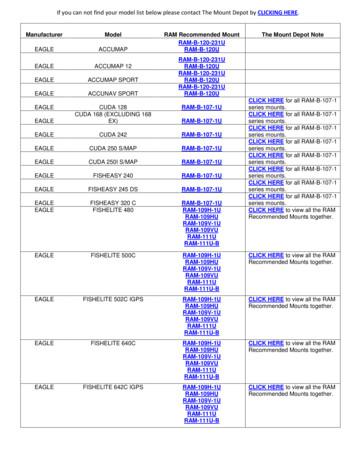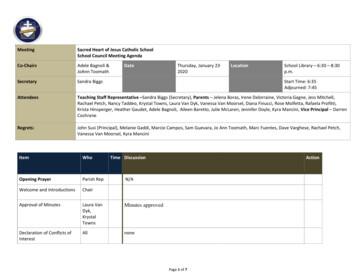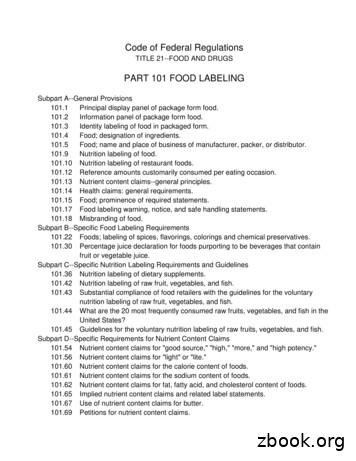Spectrum 101 Final - FEB 2016 Final
Authorized for Public ReleaseSpectrum 101An Introduction to National Aeronautics and SpaceAdministration Spectrum ManagementFebruary 2016
Table of Contents1. Introduction . 11.1 Document Structure . 11.2 What is Spectrum and Why Is It Important? .11.3 Sources of Increased Congestion and Contention . 31.4 Spectrum Opportunities and Risks for National Aeronautics and Space Administration . 31.5 Way Forward . 42. Spectrum Basics .62.1 Overview .62.1.1 Spectrum as “Fuel” .62.2 Band Designators .72.3 What is Spectrum Management? .92.3.1 Spectrum Allocation .92.3.2 Spectrum Authorization .102.3.3 Spectrum Engineering (Technical Standards) .102.3.4 Spectrum Compliance .112.4 How It Works .112.4.1 Active vs. Passive Services .123. Domestic and International Spectrum Regulatory Environment .133.1 National Spectrum Management – Dual Agency Management .133.1.1 National Telecommunications and Information Administration (NTIA) .153.1.2 Federal Communications Commission (FCC) .163.2 International Spectrum Management .183.2.1 International Telecommunication Union (ITU) .183.2.2 US Engagement in the ITU Process .183.2.3 International Spectrum Issues and NASA Equities .203.2.4 NASA Engagement with OtherInternational Entities Concerned with Space Sciences Spectrum .214. NASA Spectrum Organization and Management .234.1 NASA Spectrum Organization .234.2 NASA Frequency Allocation and AssignmentProcess and Procedures .254.2.1 Frequency Allocations . 254.2.2 Frequency Assignments . 265. NASA Spectrum Use .285.1 Overview .285.2 Earth Science .305.3 Space Science.325.4 Human Space Exploration .345.5 Aeronautics and Space Technology Development .35i
6. National Spectrum Issues and NASA Equities.376.1 Mobile Broadband .376.2 National Broadband Plan .386.2.1 Evolving Auction Policy .386.3 Spectrum Sharing .406.3.1 Sharing in 3.5 GHz .406.3.2 Sharing in the 5 GHz Band.416.4 “New Space” Issues .426.5 Global Positioning System Issues .447. Conclusion .46Attachment A – Process for Spectrum Authorization.48Attachment B – NASA WRC-15 Objectives and Results .49Attachment C – NASA WRC-19 Objectives .54Attachment D – List of Acronyms .57Attachment E – List of Figures .59Attachment F – List of Tables .60ii
Executive SummaryElectromagnetic spectrum is the valuable but limited resource that makes possible virtually everymission that the National Aeronautics and Space Administration (NASA) undertakes, including inthe areas of earth science, space science, human space exploration and aeronautical research. Yeteven as spectrum access is growing increasingly important for NASA missions, the migration ofthe Internet from wireline platforms to the world of mobile communications is creatingunprecedented pressure for more spectrum capacity to be made available for commercial wirelessbroadband services.What is Spectrum? The basic building block of radio communications are radio waves. The keycharacteristics of spectrum are the propagation features and the amount of information that signalscan carry. A signal is broadly defined as a detectable quantity (e.g., current, voltage,electromagnetic field) that varies in time. An important signal for radio communications is onewhere the quantity varies as a periodic sine wave. Frequency is the number of cycles that occur inone second and is defined in units of Hertz (Hz), which is another name for cycle per second. Thefrequency of a signal is the reciprocal of its period. The amplitude of the signal is half the peakto-peak separation of the quantity that is changing with time, e.g., voltage. In general, signals sentusing the higher frequencies have lower propagation distances but a higher data-carrying capacityand the opposite for longer wavelengths with lower frequencies makes up for the Radiofrequency(RF) spectrum. The range from 3 kiloHertz (kHz) to 300 GigaHertz (GHz) that may be used forwireless communication. Shorter wavelengths with higher frequencies make up the opticalspectrum, while the part of the spectrum that can be seen is the visible spectrum. NASA relies ona range of tools for communicating and creating images utilizing almost every single componentof the electromagnetic spectrum in one way or another.This report is designed to provide a better understanding of basic issues for NASA spectrum accessand management by addressing: what spectrum is; how it is managed; key topics with respect tointernational and domestic policy decisions; how NASA organizes its spectrum managementactivities; opportunities and challenges; and future spectrum requirements for space missions.Individual sections are modular and designed to be read either in sequence or separately to addressspecific issues based on the following chapters: (1) Introduction; (2) Spectrum Basics; (3)Domestic and International Spectrum Regulatory Environment; (4) NASA Spectrum Organizationand Management; (5) NASA Spectrum Use; (6) National Spectrum Issues and NASA Equities; (7)International Spectrum Issues and NASA Equities; and (8) Conclusion.Introduction: Like all federal spectrum users, NASA requires assured access to spectrum to reflectthe long-term nature of investments, in systems – including satellites – designed to remain inoperation for decades, versus the 18-month lifecycle of new cellphones. Thus, new commercialtechnology trends present both opportunities and challenges. In addition, passive scientific use ofspectrum – for example in the form of Earth remote sensing satellites that glean weather andclimate information – must be protected from unwanted interference in the face of expandingactivity from active services, such as wireless broadband.Spectrum Basics: A transmitter generates a radio wave, which is then detected by a receiver. Anantenna allows a transmitter to send energy into space and a receiver to pick up energy from space.iii
Transmitters and receivers are typically designed to operate over a limited range of frequencies.Use of the radio spectrum is regulated, access is controlled and rules for use are enforced becauseof the potential for interference between uncoordinated uses. Spectrum is scarce because at anytime and place, one use of a frequency precludes its use for another purpose. This has given riseto technological innovation and regulatory flexibility to increase the extent to which spectrum isshared between different users, either on the basis of time or geography.Regulatory Environment: In the US, two main policy bodies oversee spectrum use – theDepartment of Commerce’s National Telecommunications and Information Administration(NTIA) and the Federal Communications Commission (FCC). For federal spectrum, NTIA is thelead authority and for non-federal spectrum, the FCC has regulatory purview. Both agencies worktogether to ensure that policy decisions promote spectrum use consistent with both US economicinterests and government user requirements. The dual management framework used in the US isunique in the world; most other countries have a single government agency perform the spectrummanagement function over both public and private sector uses.US activities regarding international frequency management are carried out under the leadershipof the Department of State (DoS), whose role is to ensure the US speaks with one voice and thatall applicable precedents and treaties are followed.International regulation and coordination of spectrum use occurs through the InternationalTelecommunication Union (ITU), in compliance with a set of international rules and regulations(also known as the Radio Regulations). The ITU is the UN agency for matters dealing withinformation and communications technology. The State Department, along with NTIA and theFCC, oversees US preparations for ITU meetings. The ITU publishes the Radio Regulations (RR)as agreed at World Radiocommunication Conferences (WRCs), which occur every three to fouryears and update the RR, including spectrum allocations to various services. ITU member nationsgenerally develop national frequency management regulations consistent with the RR.NASA Spectrum Management: Within this overarching national policy framework, NASAorganizations manage the Agency’s use of spectrum and ensure NASA access to spectrum for allmissions using space-based and ground-based assets. The NASA Spectrum Management Programensures that all NASA activities comply with national and international rules and regulationsapplicable to spectrum use and facilitates securing spectrum and orbital resources (bothdomestically and internationally) to enable aeronautical and space mission requirements.Agency spectrum management responsibilities reside in the Space Communications andNavigation (SCaN) program office. SCaN’s Deputy Associate Administrator oversees the overallplanning, policy development, and administration of the NASA Spectrum Management Program.The Director of Spectrum Policy and Planning oversees: NASA activities to obtain adequateinternational and national allocations of frequency bands; to pursue coordination of proposedNASA frequency use with other domestic and foreign users of the frequencies; and to obtainapproval of frequency assignments by NTIA. The National and
spectrum, while the part of the spectrum that can be seen is th e visible spectrum. NASA relies on a range of tools for communicating and creating images utilizing almost every single component of the electromagnetic spectrum in one way or another. This report is designed to provide a better unde rstanding of basic issues for NASA spectrum access
Verkehrszeichen in Deutschland 05 101 Gefahrstelle 101-10* Flugbetrieb 101-11* Fußgängerüberweg 101-12* Viehtrieb, Tiere 101-15* Steinschlag 101-51* Schnee- oder Eisglätte 101-52* Splitt, Schotter 101-53* Ufer 101-54* Unzureichendes Lichtraumprofil 101-55* Bewegliche Brücke 102 Kreuzung oder Einmündung mit Vorfahrt von rechts 103 Kurve (rechts) 105 Doppelkurve (zunächst rechts)
FISHFINDER 340C : RAM-101-G2U RAM-B-101-G2U . RAM-101-G2U most popular. Manufacturer Model RAM Recommended Mount The Mount Depot Note . GARMIN FISHFINDER 400C . RAM-101-G2U RAM-B-101-G2U . RAM-101-G2U most popular. GARMIN FISHFINDER 80 . RAM-101-G2U RAM-B-101-G2U . RAM-101-
UOB Plaza 1 Victoria Theatre and Victoria Concert Hall Jewel @ Buangkok . Floral Spring @ Yishun Golden Carnation Hedges Park One Balmoral 100 100 100 100 100 100 100 100 100 100 100 100 100 100 100 101 101 101 101 101 101 101 101 101. BCA GREEN MARK AWARD FOR BUILDINGS Punggol Parcvista . Mr Russell Cole aruP singaPorE PtE ltd Mr Tay Leng .
We will begin with an overview of spectrum analysis. In this section, we will define spectrum analysis as well as present a brief introduction to the types of tests that are made with a spectrum analyzer. From there, we will learn about spectrum analyzers in term s of File Size: 1MBPage Count: 86Explore furtherSpectrum Analysis Basics, Part 1 - What is a Spectrum .blogs.keysight.comSpectrum Analysis Basics (AN150) Keysightwww.keysight.comSpectrum Analyzer : Working Principle, Classfication & Its .www.elprocus.comFundamentals of Spectrum Analysis - TU Delftqtwork.tudelft.nlRecommended to you b
Absorption Spectrum of Hydrogen Emission Spectrum of Mercury Emission Spectrum of Lithium Emission Spectrum of Helium Emission Spectrum of Hydrogen Spectrum of White Light Line Spectrum: hf Eu-El Equations Associated with The Bohr Model Electron's angular momentum L Iω mvrn nh/2π, n 1,2,3 n is called quantum number of the orbit Radius of a .
Jan 30 Last day of Ukulele Kids session 1 Jan 30 Dental Screening (K & Gr. 2) Jan 30 Girls Basketball Tournament Feb. 6 Pasta Night Feb 13 School Valentine’s Day celebrations Feb 14 PA Day Feb 17 Family Day Feb 19 Confirmation Retreat Gr. 7 Feb 22 Gr. 7 Confirmation Feb 25 Shrove Tuesday/ Pancake Tuesday Feb 26 Ash Wednesday
101.5, 101.8, 101.9, 101.13, 101.17, 101.36, subpart D of part 101, and part 105 of this chapter shall appear either on the principal display panel or on the information panel, u
towards banking products that may suit your needs, but they are not usually Independent Financial Advisers (IFAs) and therefore cannot advise you on what decisions to take or what is available from other banks. 8 British Bankers’ Association An IFA is a professional who provides financial services advice to individuals, businesses and other groups. They can provide investment, insurance and .























